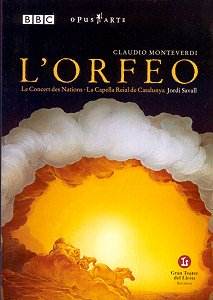Things start impressively with magisterial conductor
Savall sweeping down the centre aisle of this gorgeous theatre in flowing
black robes with the costumed renaissance band setting a brilliant and
festive mood. However the first two persons to sing - La Musica (Montserrat
Figueras) and Second Shepherd (Francesc Garrigosa), afflicted with pitch
and timing problems - had me checking the clock to see how much of this
was left to endure. Fortunately things got much better in a hurry. Starting
with Shepherd IV, a superb counter-tenor, the singing from then on was
faultless. Particularly to be mentioned are the Messagiera of Sara Mingardo
and the Orpheus of Furio Zanasi, both of whom have difficult solo roles
and both of whom magnificently carry the day as vocal actors. Whether
those were real tears or good makeup on Ms. Mingardo’s face I don’t
know, but my tears were real.
The musicians play superbly, and the period instruments
not only sound good but look good, too. Curious to see modern trumpets
and trombones in among the theorbos and sackbutts but with sound this
beautiful who’s complaining? The choreography is excellent, not just
in the dances but in the way the chorus moves and arranges itself on
stage. Several of the solo dancers particularly distinguish themselves.
Sets are grand in the baroque manner with floating clouds, Apollo on
his chariot, lots and lots of mists and vapours, and a whole curtain
of mirrors.
For once we have the chance to enjoy the curtain calls
without the credits being rolled up over them. Montserrat Figueras,
"La Musica," got a huge ovation from the audience, but then
she is the conductor’s wife and a hometown girl made good. The star
Furio Zanasi who sang and acted brilliantly in a long and difficult
solo role got the cold shoulder from the audience for no reason I could
ascertain. He was a true professional and covered his injury by smiling
extra broadly and bowing extra deeply.
Even though the disk is labelled as 16:9 format, I
could not get my DVD player to display it in wide-screen, nor could
I get it to operate in surround sound, although the sound I did get
was exceptionally clear and ambient. I also had a heck of a time getting
rid of the Story Synopsis when what I wanted was the Main Menu. I suppose
this is because my player is two years old and they are still playing
with the DVD disc format.
There are at least three other Orfeos available
on video of which I have seen only the Harnoncourt/Ponnelle. If you
have that one, overall there is no reason to buy this one, however if
you currently have no version in your collection, this version is to
be preferred over that one. This Orfeo is much more compelling
on a human level; the Harnoncourt/Ponnelle at times seems almost to
be a puppet show, the acting and staging are so stylised and exaggerated.
This Orfeo is a theatre production with a real stage and (very
quiet) live audience, while the Harnoncourt is a studio production;
in this case the live dimension adds a lot to one’s enjoyment.
Paul Shoemaker

